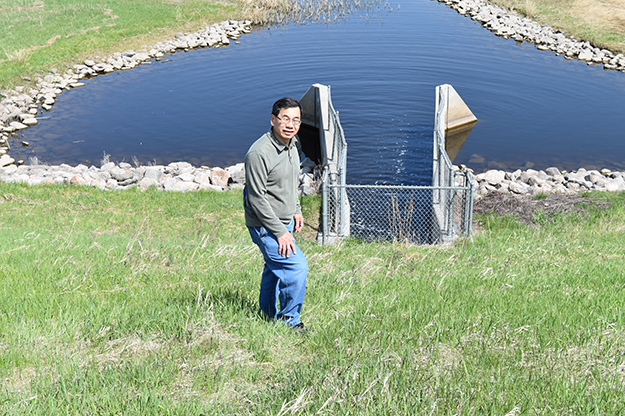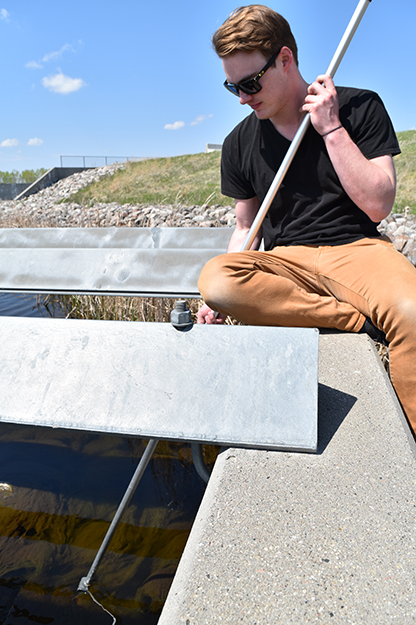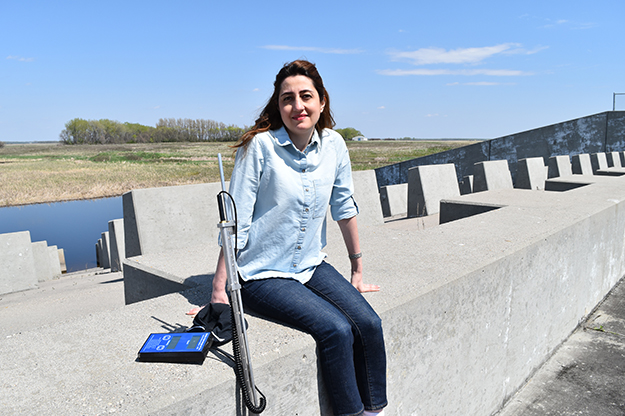Flood of research
UND civil engineer Howe Lim and his student team develop solutions to region’s temperamental waters

The impressive concrete spillway at the western end of the English Coulee in Grand Forks looks more like a World War I battlement.
But this structure is not a defense against cannonades: its main purpose is to control the flow of flood water.
It’s where Yeo Howe Lim, a faculty member in the UND Department of Civil Engineering, and his team of graduate students do a lot of their research.
“The main focus of our research now is in the hydrology of the snow melt,” says Lim. “We use computer modeling that we developed ourselves to help us predict flooding based on what we observe with the snow melt.”

And that’s the key word: flooding.
Anyone who’s lived on the Northern Plains knows lots about the perennial risk of floods, big, small, local and region-wide.
“Sure,” says Lim, “North Dakota—and northwestern Minnesota—is unique because of the combination of its flat terrain and cold conditions. That often leads to lots of water stored in ground and frozen before winter starts. Then you get the snow piling on and melting in the spring. Often the upstream snow melts before the downstream snow melts, then you get ice jam formation—so the water backs up during the spring melt.”
Lim and his team also do flood frequency analysis—how often it floods and the magnitude of the flooding.
“We also look at changes such as climate and land use—and we use modeling again to predict what may happen. We use both hydrology—the movement of water above and below ground—and hydraulics—how fluids behave in pipes and channels—to make our predictions.”
Lim’s research strategy involves three areas of inquiry:
- Flood hydrology—studying large scale water movements, that is, across large landscapes such a whole basin or catchment. The team looks at this scale to determine at how much water is flowing across the landscape.
- Hydraulics—what happens to flood flow on structures such as culverts, bridges, dams and impoundments.
- Transport of sediment particles and location of deposition, such as Devils Lake, the Red River, and the Sheyenne River. Lim notes that special membranes are needed in water treatment, for example, to catch sediment. And in events such as flood, sediment transport and deposition accelerates as the movement of water—the flow—increases.
Lim works collaboratively with other disaster and water experts across campus, such as Geography’s Paul Todhunter, an expert in hazards who has extensively studied flooding, including in the Devils Lake basin. He also collaborates with Earth Systems Science on a NASA grant to research the hydrology of Devils Lake, with a view to predict what’s going to happen there—i.e., is that lake going to rise some more or will it start receding.
“For that project, we use data from many sources, including NASA satellite data,” says Lim. “We’re also looking at climate and carbon emissions that will change the climate, and we perform hydrologic modeling on the ground and simulate climate conditions, including future precipitation–rain and snow.”
Part of what Lim studies are the major differences between lake flooding—such as the decades-long rise in the Devils Lake basin—and river flooding.
“The water that flows into Devils Lake stays there—there is no natural outlet there now like there was many thousands of years ago. There’s no continuous flow out or it’s very slow,” says Lim, who came to the UND College of Engineering & Mines in 2003. “It’s a big lake with lots of streams flowing into it. Eventually that water spills into Stump Lake and Sheyenne River.”
“We need to create a spill to control outflow—including pumping it out—because we need to protect areas downstream,” he says.
Lim also works with the North Dakota State Water Commission, the Garrison Diversion Water Conservancy District, and U.S. Army Corp of Engineers.
Lim’s interest in water issues developed from growing up in Malaysia, a tropical country with lots of rainfall.
“We get daily rainfall, and flooding is a big issue,” said Lim, who noted that he’s seen the tremendous results from uncontrolled water flows. Following his master’s degree studies in New Zealand, he got a job as a hydrologist in Malaysia and taught at a university there. With an urge to conduct further research in flood hydrology, he pursued his Ph.D. in Newfoundland, Canada. Lim is faculty advisor to the UND chapter of Engineers Without Borders.

Getting the scoop
One of Lim’s graduate students, Bahareh Shoghli, says her research starts with climate change.
“Changes in climate cause precipitation changes, temperature changes, and evaporation changes,” says Shoghli, who started her Ph.D. work at UND in 2014. “I want to know what will happen in the reservoirs and dams as a result of climate change.”
At the English Coulee dam and impoundment west of Grand Forks, Shoghli, who grew up in Tehran, Iran, points to the base of the heavily reinforced concrete spillway.
“Sedimentation is a factor in the reservoirs, mostly because it decreases storage capacity,” she said. “Increased precipitation causes increased overflow and can result in flooding.”
Part of her work includes studies conducted at Lake Ashtabula and at Baldhill Dam watershed areas—both areas that see a lot of snow. She’s working on more sophisticated modeling software to help predict flooding because existing software cannot simulate the impacts of the snow melt.
“We have 100 years-plus of data but we don’t know if the data used to design these dams makes them sufficient for current climate conditions,” Shoghli said. “My research indicates that these small dams as well as the reservoirs associated with them are inadequate—they are impacted more by climate change. So part of what I’m asking is what should we do to improve the dams.”
Ultimately, Lim and his student team—including Shoghli—are looking at a key goal: improving the prediction of flooding.
“That’s a big deal in North Dakota,” Lim says.


